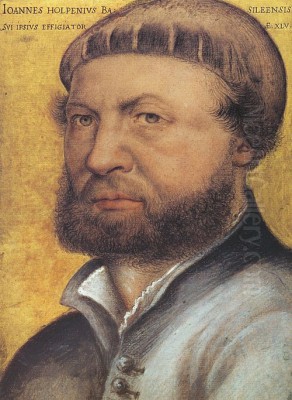
Hans Holbein the Younger stands as one of the most accomplished and influential artists of the Northern Renaissance. Active during a tumultuous period of religious reformation and cultural exchange in the early 16th century, this German painter and printmaker forged a unique artistic identity, primarily celebrated for his penetratingly realistic portraits. Though born and trained in Germany, Holbein achieved his greatest fame in England, becoming the court painter to King Henry VIII. His work masterfully blended the meticulous detail characteristic of Northern European art with the compositional grace and burgeoning humanism of the Italian Renaissance, leaving an indelible mark on the history of art, particularly in the realm of portraiture.
Origins in Augsburg: An Artistic Heritage
Hans Holbein the Younger was born in the free Imperial City of Augsburg, Southern Germany, likely around the winter of 1497 or early 1498. He hailed from a distinguished artistic lineage. His father, Hans Holbein the Elder (c. 1460–1524), was a respected painter working in the Late Gothic style, known for his altarpieces and portraits. The elder Holbein ran a busy workshop, providing an immersive artistic environment for his sons. Hans the Younger, along with his older brother Ambrosius Holbein (c. 1494–c. 1519), received his initial training under their father's guidance. Augsburg itself was a vibrant cultural and economic hub, open to the influences of the Italian Renaissance filtering across the Alps, which likely shaped the young artist's outlook.
The training in his father's workshop would have involved mastering various techniques, from drawing and panel preparation to painting and possibly designing for stained glass and woodcuts. This comprehensive grounding provided the technical foundation upon which Holbein would build his remarkable career. The influence of his father's style, particularly in its solid forms and clear delineation, can be discerned in Holbein's earliest works, though he would soon surpass his father in refinement and psychological depth.
The Basel Years: Foundations and Humanism

Around 1515, seeking broader opportunities, Hans and Ambrosius moved to Basel, Switzerland. Basel was a major center of learning and printing, deeply influenced by Renaissance humanism. This environment proved crucial for Holbein's intellectual and artistic development. He quickly found work, initially undertaking diverse commissions such as painting shop signs and designing woodcuts for printers like Johann Froben. His brother Ambrosius also established himself as a journeyman painter but appears to have died young, around 1519.
In Basel, Holbein came into contact with the leading humanist scholar of the age, Desiderius Erasmus of Rotterdam, who had settled there to work with Froben. Holbein provided marginal drawings for a copy of Erasmus's satirical work In Praise of Folly (Encomium Moriae) around 1515/1516. This connection blossomed, and Holbein would later paint several definitive portraits of Erasmus, cementing the scholar's image for posterity. He also befriended other humanists and patrons, such as the lawyer Bonifacius Amerbach, whose portrait he painted in 1519.
During his Basel period, Holbein undertook significant religious commissions. Among his most powerful early works is The Body of the Dead Christ in the Tomb (1520–22), a harrowing depiction of Christ's corpse rendered with unflinching realism and anatomical precision. He also painted altarpieces, including the Oberried Altarpiece (fragments survive), and devotional paintings like the Solothurn Madonna (c. 1522) and the magnificent Darmstadt Madonna (or Madonna of Mayor Jakob Meyer zum Hasen, c. 1526-28), a group portrait combining religious devotion with civic pride. His early portraits, such as those of Jakob Meyer and his wife Dorothea Kannengiesser (1516), already show his keen eye for individual likeness and texture. He also worked on large-scale decorative projects, notably frescoes for the Council Chamber of Basel's Town Hall, though only fragments remain.
First Journey to England: Seeking Opportunity
The rising tide of the Protestant Reformation brought iconoclasm to Basel, severely curtailing the market for religious art. Seeking new avenues, Holbein traveled to England in 1526, armed with a letter of introduction from Erasmus addressed to the influential statesman and scholar Sir Thomas More. This connection proved invaluable, granting Holbein access to the highest circles of English society and the burgeoning humanist movement centered around More.

During this first English stay, which lasted until 1528, Holbein established himself as a portrait painter of the first rank. He produced a masterful portrait of Sir Thomas More himself (1527), capturing his intelligence and integrity. He also painted other members of More's circle and the Tudor court, including William Warham, Archbishop of Canterbury (1527), Sir Henry Guildford (1527), and the German astronomer Nicholas Kratzer (1528), who was tutor to More's children. A particularly ambitious project was a large group portrait of Sir Thomas More's family, now lost but known through a preparatory drawing and copies, which was unprecedented in English art at the time. This period solidified Holbein's reputation for lifelike representation and technical brilliance.
Return to Basel Amidst Turmoil
Holbein returned to Basel in 1528, perhaps intending to maintain his citizenship and family ties (he had married Elsbeth Binzenstock, a widow, around 1519, and they had children). He purchased a house and continued some work, including completing the Council Chamber frescoes. However, Basel had officially adopted the Reformation in 1529, and the climate for artists remained challenging. Commissions were scarce compared to the opportunities he had found in England. After four years, recognizing that his future lay elsewhere, Holbein decided to return to London in 1532, this time leaving his family behind in Basel.
Court Painter to Henry VIII: The London Pinnacle
Holbein's return to London in 1532 marked the beginning of the most productive and prestigious phase of his career. His former patron, Sir Thomas More, had fallen from royal favour due to his opposition to Henry VIII's break with the Roman Catholic Church. Holbein initially found patronage among the community of German merchants of the Hanseatic League, known as the Steelyard. His portraits of these merchants, such as the richly detailed depiction of Georg Giese (1532), are masterpieces of observation, showcasing the tools and symbols of their trade.
Through new connections, possibly facilitated by Anne Boleyn or Thomas Cromwell, Holbein soon gained access to the royal court. By 1536, he was receiving a salary as the King's Painter. This position brought him unparalleled prestige and a steady stream of commissions. His most iconic image of Henry VIII (c. 1537) originated from a large wall painting executed for Whitehall Palace (destroyed by fire in 1698, but known through copies and Holbein's own related portraits, like the one in the Thyssen-Bornemisza Museum). This portrayal, emphasizing the King's imposing physical presence and regal authority, became the definitive image of Henry VIII.
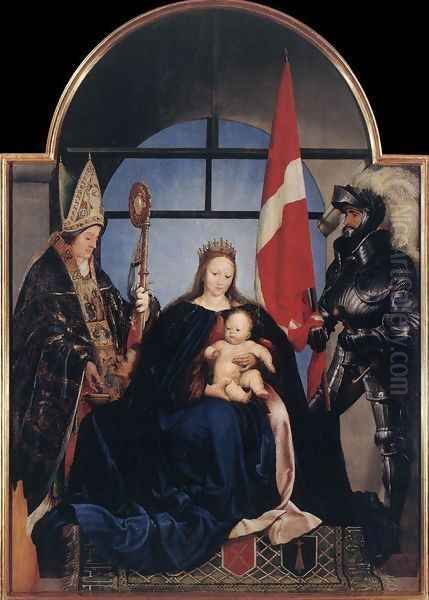
As court painter, Holbein documented the key figures of the Tudor court. He painted portraits of Henry's queens, including Jane Seymour (c. 1536-37) and Anne of Cleves (1539) – the latter painted during a diplomatic mission to Düren to provide the King with an accurate likeness of his prospective bride. He also captured the likenesses of powerful courtiers like Thomas Cromwell (c. 1532-33), Sir Richard Southwell (1536), and visiting dignitaries such as the French ambassador Charles de Solier, Sieur de Morette (1534-35). Alongside large-scale panel paintings, Holbein excelled in the art of miniature portraiture, creating small, jewel-like likenesses that were highly prized.
The Art of Observation: Holbein's Portraiture
Holbein's approach to portraiture was characterized by intense observation and meticulous execution. He typically began with highly detailed preparatory drawings, often using coloured chalks, ink, and wash on prepared paper. These drawings, many of which survive at Windsor Castle, are remarkable works of art in their own right, capturing the sitter's features with astonishing precision and subtle characterization. Notes on colours and materials often appear on these sketches.
The information from the drawing was then transferred to a prepared wood panel for the final oil painting. Holbein achieved an almost photographic realism, rendering textures of fabric, fur, metal, and flesh with uncanny skill. Yet, his portraits are more than mere surface likenesses. While generally objective and avoiding overt flattery, they convey a sense of the sitter's presence, status, and sometimes their inner life. He masterfully used costume, jewellery, and symbolic objects to denote rank, profession, and intellectual interests, embedding his subjects within their social and cultural context.
Compared to his Italian contemporaries like Raphael or Titian, Holbein's portraits are often less idealized and more grounded in specific reality. Compared to Northern peers such as Lucas Cranach the Elder, court painter in Saxony, Holbein's work often exhibits greater psychological penetration and a more sophisticated integration of Italian Renaissance principles of composition and volume, while retaining the Northern European love of detail inherited from masters like Jan van Eyck.
Decoding The Ambassadors
Perhaps Holbein's most complex and debated work is The Ambassadors (1533), now housed in the National Gallery, London. This life-sized double portrait depicts Jean de Dinteville, French ambassador to England, and his friend Georges de Selve, Bishop of Lavaur, who visited London that year. The painting was created during a period of intense political and religious tension, as Henry VIII was finalizing his break with the Papacy to marry Anne Boleyn.
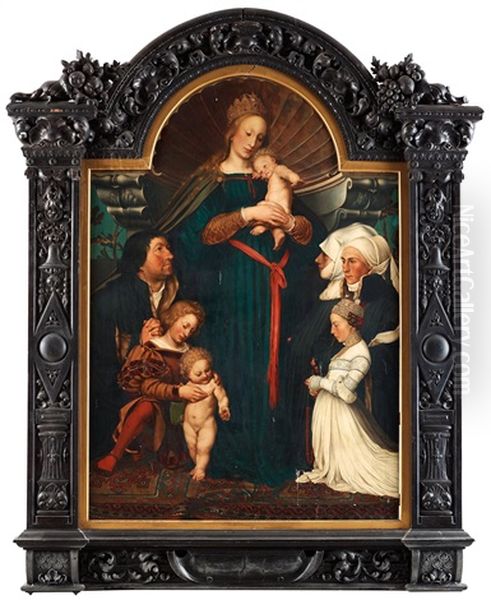
The two men stand beside a high table laden with objects representing the 'quadrivium' of Renaissance learning: astronomy and geometry on the upper shelf (celestial globe, sundial, quadrant), and arithmetic and music on the lower shelf (arithmetic book, lute with a broken string, case of flutes, Lutheran hymn book). These meticulously rendered objects symbolize worldly knowledge, accomplishment, and perhaps the discord of the times (the broken lute string, the specific page in the hymn book).
Most famously, the painting features a large, distorted shape hovering across the foreground floor. When viewed from a specific oblique angle (usually from the right), this resolves into a human skull – an anamorphosis. This striking memento mori (reminder of death) serves as a powerful counterpoint to the worldly achievements displayed above, reminding the viewer of mortality and the vanity of earthly pursuits. The skull's technical execution is a dazzling display of Holbein's mastery of perspective, possibly reflecting contemporary interests in optics, perhaps even echoing Leonardo da Vinci's experiments. The precise meaning of the painting, including the specific symbolism of each object and the overall message intended by the patrons and the artist, continues to be analyzed and debated by art historians.
Mastery Across Mediums: Technique and Style
Holbein's technical virtuosity extended across various mediums. His oil painting technique involved building up thin layers of glaze over a detailed underdrawing on smooth gessoed panels, achieving luminous colour and exquisite detail. His drawing style, particularly in his portrait studies, often employed parallel hatching rather than the cross-hatching favoured by contemporaries like Albrecht Dürer, creating subtle tonal transitions.
While deeply rooted in the Northern tradition, Holbein absorbed lessons from Italian art, likely encountered during undocumented travels to Northern Italy or France early in his career, or through prints and contact with other artists. Influences from artists like Andrea Mantegna or the Lombard realists might be detected in his handling of form and perspective. His compositions often show a Renaissance sense of balance and structure, sometimes employing pyramidal arrangements reminiscent of Leonardo. He seamlessly fused these Southern European elements with Northern precision and realism.
His skill in miniature painting was exceptional, influencing the development of the art form in England. These small portraits, often set in elaborate jewelled cases, required incredible precision and control.
Beyond the Easel: Prints and Designs
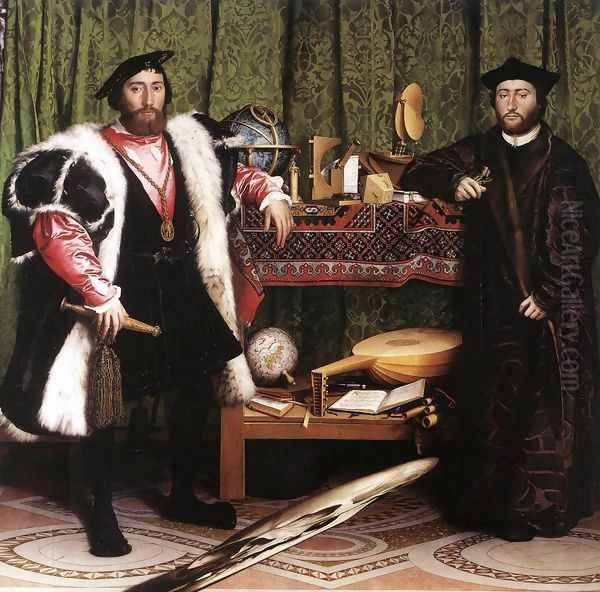
Holbein was also a prolific designer of woodcuts. His most famous series is The Dance of Death (Les Simulachres & Historiées Faces de la Mort), designed probably between 1523 and 1526, but first published in Lyon in 1538. This powerful series of small prints depicts Death, personified as a skeleton, intruding upon the lives of individuals from all social strata, from the Pope and Emperor to the peasant and child. Its satirical edge and artistic brilliance made it immensely popular and influential throughout Europe. He also designed illustrations for the Old Testament and title pages for various books.
Furthermore, Holbein's talents extended to decorative design. He created patterns for goldsmiths' work, jewellery, elaborate state costumes, and temporary festive decorations. While less documented, he may also have designed stained glass. This versatility demonstrates the broad scope of a Renaissance artist's practice.
Holbein and His World: Artistic Connections
Holbein's career intersected with many key figures of his time. His primary artistic formation came from his father, Hans Holbein the Elder, and the Late Gothic tradition. His brother Ambrosius was an early collaborator. While a direct meeting with Albrecht Dürer, the leading figure of the German Renaissance, is not recorded, Holbein was certainly aware of his work, though their styles differed significantly.
Potential indirect influence from Leonardo da Vinci, particularly regarding optics or compositional strategies, is plausible given Holbein's likely travels and the circulation of artistic ideas, but there is no evidence of direct contact. He was part of a network of Northern artists, including contemporaries like the Antwerp painter Quentin Matsys, who also painted Erasmus, and perhaps Joos van Cleve. He would have known the work of German contemporaries like Lucas Cranach the Elder.
His most significant personal connections were with humanists like Erasmus and Sir Thomas More, who were crucial patrons. In France, his work relates to the court portraiture tradition exemplified by Jean Clouet and his son François Clouet. In Italy, besides Leonardo, artists like Andrea Mantegna may have offered inspiration. Holbein's unique position allowed him to synthesize diverse influences into a style entirely his own.
Final Years and Unforeseen End
Hans Holbein the Younger continued to work successfully as Henry VIII's court painter throughout the late 1530s and early 1540s. He maintained his high level of production and quality. However, his life was cut short prematurely. In the autumn of 1543, London was struck by an outbreak of the plague. Holbein fell victim to the epidemic. He made his will on October 7, 1543, and was buried sometime before November 29. He was likely in his mid-forties at the time of his death.
Enduring Legacy: Holbein's Imprint on Art
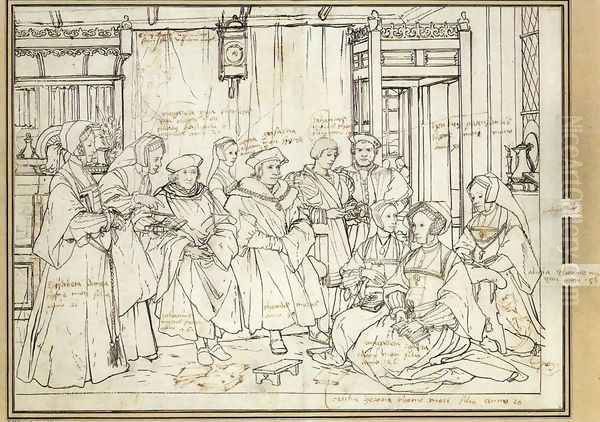
Despite his relatively short life, Hans Holbein the Younger left an extraordinary legacy. He is universally regarded as one of the greatest portraitists in the history of Western art. His work provided a definitive visual record of the Tudor court and its leading personalities during a pivotal era in English history. His realistic, objective style set the standard for portraiture in England for decades after his death.
His influence was profound, particularly on the development of the English school of portrait painting. Later miniaturists like Nicholas Hilliard (c. 1547–1619) and Isaac Oliver (c. 1565–1617) explicitly acknowledged their debt to Holbein's example. His linear precision, meticulous detail, and ability to capture individual character were admired and emulated. His prints, especially The Dance of Death, continued to be reprinted and inspired artists for centuries.
Art historically, Holbein occupies a crucial position, bridging the late Gothic and Renaissance periods, and synthesizing Northern and Southern European artistic traditions. His technical mastery, combined with his insightful portrayal of humanity, ensures his enduring status as a master artist whose works continue to fascinate and resonate with viewers today.
Conclusion
Hans Holbein the Younger was more than just a court painter; he was a consummate artist whose skill transcended borders and mediums. From his roots in Augsburg and formative years in Basel to his celebrated career in Tudor England, he consistently produced works of exceptional quality and insight. His portraits remain unparalleled in their combination of objective realism and subtle characterization, offering a vivid window onto the people and the complex era in which he lived. Through his paintings, drawings, and prints, Holbein created a legacy that profoundly shaped the course of portraiture and secured his place among the giants of the Northern Renaissance.